How Dogs Love Us
Air Date: Week of November 29, 2013
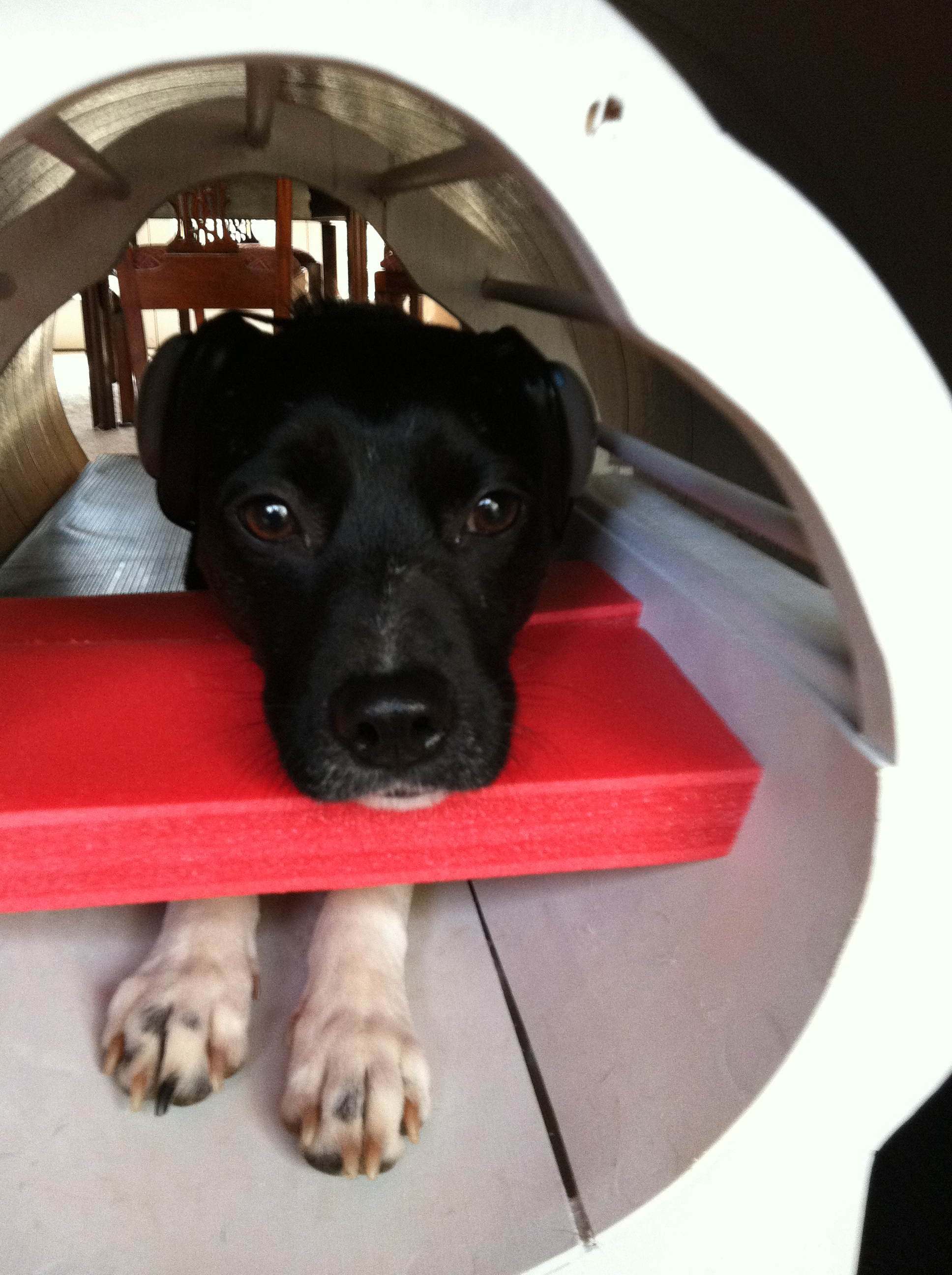
Callie, one of the first dogs to have their brain waves captured, waits in the MRI machine. (Greg Berns)
Using brain scans from magnetic resonance imaging (MRI), Greg Berns attempted to discover if dogs really do love us. He joins our host Steve Curwood to discuss his recent discovers and insights into the relationship between canine and human.
Transcript
CURWOOD: It's Living on Earth, I'm Steve Curwood. Most people who have a dog are sure their dog loves them—why else would their pooch seem so sad when they leave and be so tail-bangingly happy when they return? Now a researcher is using MRI brain scans to offer scientific proof that dogs indeed have emotions similar to those of humans. Professor Gregory Berns, a professor of neuro-economics at Emory University, recently wrote a book called How Dogs Love Us: A Neuroscientist and His Adopted Dog Decode the Canine Brain. Professor Berns joins me now from Atlanta, Georgia, but before we talk about dogs and their emotions, tell me, what exactly is a neuro-economist?
BERNS: A neuro-economist is someone, like me, who uses neuroscience technology to understand human decision-making.
-Bryan-Meltz.jpg)
Professor Gregory Berns is the leader of the team working to examine the canine brain. (Greg Berns)
CURWOOD: How did you come up with the idea to study the canine brain using an MRI machine?
BERNS: Funny story - well, funny and sad story, I guess. It was a couple of years ago after one of my favorite dogs passed away - it was a pug, named Newton, and he lived to the ripe old age of almost 15 - and it was kind of remarkable after 15 years with such a dog you become pretty attached to them, and I think it got me wondering what Newton had been thinking all those years, and whether he had anything like the feelings that I had for him. Could we actually use the technology I had been using in humans and train it on the canine brain to try to understand how a dog’s mind works.
CURWOOD: So tell me, how are dog brains and human brains different?
BERNS: When you look at them, at first glance, there are some very obvious differences, and in fact, you don’t need an MRI to know that a dog’s brain is quite a bit smaller than a human brain. But in the world of neuroscience, brain size is not necessarily everything. So once you take size out of the equation, then the thing you notice is that the dog brain has a very large part of its brain devoted to smell, and we call it the olfactory bulb, and it’s kind of this projection that comes out in front of the brain that kind of sits above the nose of the dog.

Tigger, a Boston terrier, poses with brain scans. (Greg Berns)

Rosey, a Doberman, trains with owner Marci Soran with a mock version of an MRI. (Greg Berns)

Greg Berns works with one of the canines to examine response to hand signals. (Greg Berns)
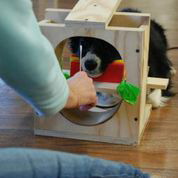
Caylin, a sheep dog, trains in preparation for the sniff experiment. (Greg Berns)
A series of images of the canine brain. (Greg Berns)
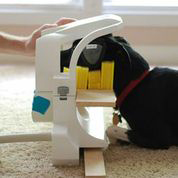
Callie practices in preparation for the MRI machine. (Greg Berns)
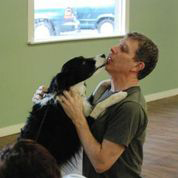
Caylin gives Greg Berns a big kiss. (Greg Berns)

Pearl, a golden retriever, gives vet tech Rebeccah Hunter a big kiss. (Greg Berns)
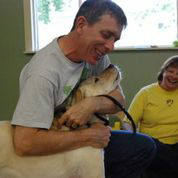
Greg Berns gives Friday, a yellow lab, a big hug. (Greg Berns)
Now, humans have kind of tiny olfactory bulbs, in fact, you have to look really hard to find them on an MRI, but in a dog, it’s probably about 10 percent of the brain. Now that says what’s different, but there’s also a lot that’s in common. In fact, all mammalian brains have many structures in common, and when you look at certain parts of the brain like the brain stem, and parts of the brain called the limbic system, and the basal ganglia, these are pretty much common to all mammals and many non-mammals as well. And so that exists in a dog, just like humans.
CURWOOD: So now, this part of the brain is called the caudate region, and it’s common to dogs and to people.
BERNS: It’s common to dogs, people, monkeys, chimps, rats, every mammal has this part of the brain, and it basically serves a fundamental function of being a living, breathing animal, which is that you have to know what’s good and what’s bad, and approach those things that are good, and run away from those things that are not good. So in humans, when we do these experiments, you know, when we show people things like money, or they get money or food that they like, and you can ask them what they’re feeling, what kind of emotions are associated with that, almost always, it’s some kind of positive emotion.
CURWOOD: And, of course, you point to a basic problem - people tell you they like these things, but dogs, at least my dog, doesn’t really talk that precisely.
BERNS: Exactly, and that’s the whole reason we’re doing the fMRI on dogs. So the idea of the project then, is that by training the dogs to go in the scanner and holding still enough to do this, if we can show them things that they like that are similar, then we can use their brain activation as a kind of way to bridge between the dog and the human world.
CURWOOD: So tell me about the dogs in this experiment. You had your dog, Callie, and another dog, McKenzie. What were they like?
BERNS: So Callie is kind of terrier mix and the other dog, the initial two dogs, the other one was a border collie named McKenzie.
CURWOOD: So explain the two experiments that were used in this project for me?
BERNS: The original experiment was just to prove a concept because nobody thought this would work. So our first experiment was to prove that we could do this, and that we could get interpretable data from the dog’s brain. For that experiment, we trained the dogs on two hand signals, so one hand signal meant, you’re going to get a piece of hot dog, and another signal meant no hot dog. We purposely picked something that was easy that had a high chance of success, and because we knew about the caudate nucleus in humans, we also knew to look there in the dog brain. So the theory was that if the dogs were understanding hand signals, we should see activity in this part of the brain to the hand signal that means they’re going to get food.
CURWOOD: So these had to be really stinky hot dogs, right?
BERNS: Well, it’s funny you should bring that up because actually the earliest version of this experiment we did was, we actually had peas, like the vegetable, a pea and a hot dog because we thought, “well obviously the dogs are going to like the hot dogs more than peas”, and that experiment actually didn’t work. There was no difference in brain activity between peas and hot dogs, and we then realized after we did it that, the dogs actually didn’t care that much what they were eating - they just liked to eat the food.
CURWOOD: Professor, talk to us a little bit about the sniff experiment, how dogs tease out the difference between their owners and others, and other dogs for that matter.
BERNS: Sure, so one of our later experiments is getting away from hand signals and getting closer to what we think the dog’s primary sense is, which is smell. So one of the things we’ve done is present smells to the dogs while they’re in the scanner, and in the initial experiment we presented five smells - presented the scent of a familiar human in the household, a familiar dog in the household, and then we had unfamiliar people, unfamiliar dogs, and then we actually presented the dog’s own scent to them while they were in the scanner. So what we’ve seen now, and we’ve done this in 12 dogs, is that, again the same part of the brain, the caudate nucleus, seems to react exclusively in this experiment, to the scent of a familiar human, and that’s pretty remarkable because the scent of a human was obtained not from the person who is actually handling the dog in the scanner, but from someone else in the household. So that means that the dogs recognize that scent, and they have some memory for that person who’s not there physically, that are distant in time and space, and that it seems to be associated with a positive...we call it a positive emotional response.
CURWOOD: So, Professor, summarize for me the results you obtained and the work you describe in the book here.
BERNS: We’re kind of left with two big results, I would say, so the first is that we can demonstrate this positive response, first for hand signals, meaning hot dogs, but more importantly, with regards to smells, that it also transfers to the smell of people that the dog lives with. And this is important because kind of going into that we didn’t know whether the dog’s primary bond, if you will, in a household full of dogs and people would be with people or their fellow canine companions. You know, every other species out there bonds pretty much exclusively with what we call kind specifics, members of the same species. And now we’re seeing right here, with the brain data, that dogs seem, well at least dogs in our study seem, more bonded with the people in the household than the other dogs. This, to me, is incredibly important because it shows social flexibility of dogs in their ability to kind of bond to people, first and foremost.
CURWOOD: Professor, how does your dog project clarify the human-canine relationship, do you think?
BERNS: Well, we’re trying to understand the dog-human relationship from the dog’s perspective, and specifically, we are looking at brain responses in the dog, as the dog is interacting with a human. This is quite remarkable because now that we’ve done our initial experiments and proven that we can get quality data, now we’re doing much more sophisticated experiments and questions. So, for example, currently, right now, we’re trying to understand how the dog’s brain responds to these hand signals, whether it’s given by the owner, whether it’s given by a stranger, or even whether these signals are given by a computer. We’re already beginning to see differences in response of the caudate nucleus as well as other brain regions depending on who’s giving the signal.
CURWOOD: Professor, when the owner showed the hot dog sign versus the stranger showing the hot dog sign, what was the difference?
BERNS: So this is brand new work, so this is kind of just rolling right off the scanner this week. It varies by the dog. So some of our dogs seem to have essentially have caudate responses primarily, if not exclusively, to when the owner gives a signal, and not to when a stranger does. Then other dogs, I guess you could say are a little bit more promiscuous about it and don’t seem to care as much about which human gives the signal, although most all of them seem to have stronger responses when the human gives the signal than when a computer does.
CURWOOD: Your project also focused on attempting to discover if canines have what’s known as theory of mind. First, tell us what’s theory of mind, then tell us if you think dogs have this and what would be its value?
BERNS: Sure. So theory of mind is this idea...it’s thought about mostly in regards to humans. So theory of mind is what we would call mentalizing. So far only humans have been definitively identified as having that. Now it’s very controversial whether other species have this capacity. What this would mean is that dogs have some representation not just of what their humans are doing, but also what their humans are thinking or feeling.
CURWOOD: So what implications do you think there are ethically, and say, even legally, to your work discovering how the canine brain works?
BERNS: There are all sorts of implications, not just legally, but also just practically. So on the practical level, we’re trying to understand, in fact, we’re finding out, you know, for example, why certain dogs are better matched to certain people. And this is incredibly important for training, it’s important for developing service dogs, working dogs, and how they interact with humans, it’s important for understanding behavioral problems that occur in dogs which separation anxiety is one of the biggest problems that dog owners face. But on the legal plane, it’s incredibly complicated. So I’ve argued that because we’re finding brain responses that look very similar to human brain responses so much so that we can begin to infer that the dogs are experiencing emotions in many ways like we do, but this argues for treating them something more than property.
CURWOOD: Let’s go back to the question of dog rights for the moment here. Well, so, what about dog rights? At one point as you’re telling the story, you say you decide the dogs would have to volunteer, that they would have to make it clear that they were participating voluntarily in all of this.
BERNS: So we wanted the dogs to do this of their own free will. When I say of their own free will, what that means is, the dogs are not sedated, they’re not restrained in any way, so that means that they have to walk into the scanner and lay down completely on their own, and by doing so, that means that they want to be there. So we came up with this principle of self-determination, which was borrowed from the human research literature. One of the ones which is most sacred in a human is if you volunteer to be in an experiment, you have the right to withdraw from the experiment. We decided that we were going to implement that for the dogs as well.
CURWOOD: By the way, how could the study of the canine brain also help human health?
BERNS: Well, if you accept what I’m saying, that there are many commonalities between the dog brain and the human brain, both the structure and the function, you also immediately realize that they experience many of the same problems that humans do, and I’m speaking specifically emotionally. So one of the things we’ve noticed with regards primarily to anxiety, studying separation anxiety in dogs may very well teach us other anxiety disorders in humans.
CURWOOD: Gregory Berns, is a professor of neuro-economics at Emory University in Atlanta. His new book is called How Dogs Love Us: A Neuroscientist and His Adopted Dog Decode the Canine Brain. Thanks so much, Professor, for taking this time.
BERNS: My pleasure.
CURWOOD: And if you want to see some video of his experiments, please go to our website, LOE.org.
Links
Living on Earth wants to hear from you!
Living on Earth
62 Calef Highway, Suite 212
Lee, NH 03861
Telephone: 617-287-4121
E-mail: comments@loe.org
Newsletter [Click here]
Donate to Living on Earth!
Living on Earth is an independent media program and relies entirely on contributions from listeners and institutions supporting public service. Please donate now to preserve an independent environmental voice.
NewsletterLiving on Earth offers a weekly delivery of the show's rundown to your mailbox. Sign up for our newsletter today!
 Sailors For The Sea: Be the change you want to sea.
Sailors For The Sea: Be the change you want to sea.
 The Grantham Foundation for the Protection of the Environment: Committed to protecting and improving the health of the global environment.
The Grantham Foundation for the Protection of the Environment: Committed to protecting and improving the health of the global environment.
 Contribute to Living on Earth and receive, as our gift to you, an archival print of one of Mark Seth Lender's extraordinary wildlife photographs. Follow the link to see Mark's current collection of photographs.
Contribute to Living on Earth and receive, as our gift to you, an archival print of one of Mark Seth Lender's extraordinary wildlife photographs. Follow the link to see Mark's current collection of photographs.
 Buy a signed copy of Mark Seth Lender's book Smeagull the Seagull & support Living on Earth
Buy a signed copy of Mark Seth Lender's book Smeagull the Seagull & support Living on Earth

